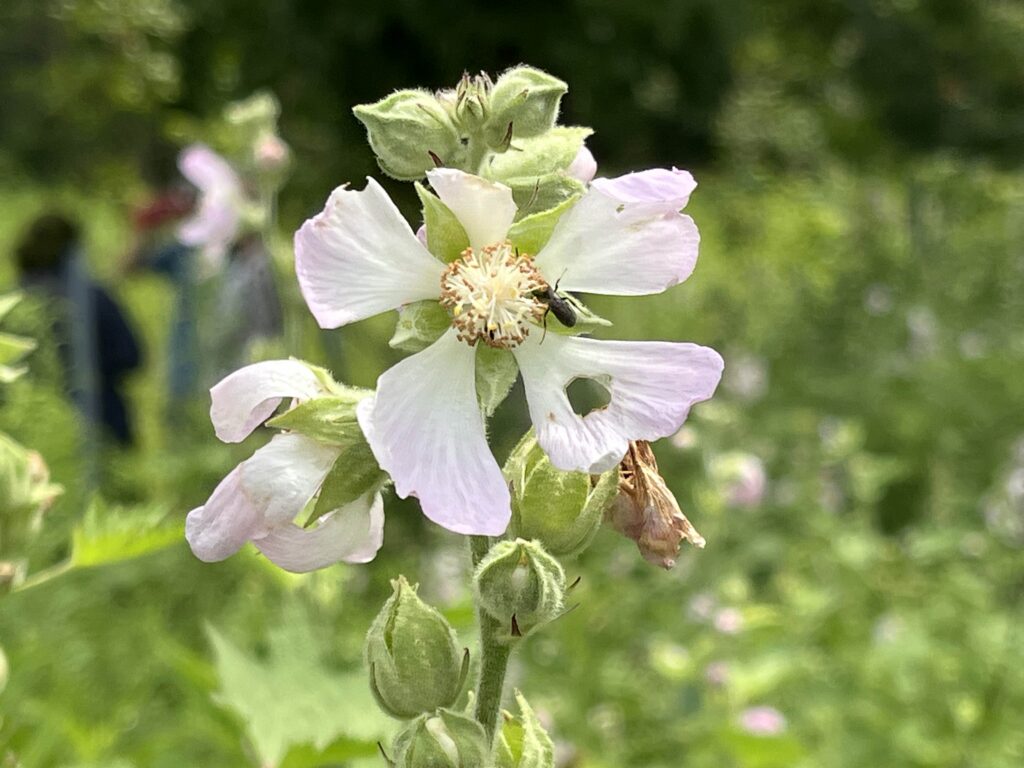Langham Island Field Trip June 29, 2024

Langham Island Field Trip: On June 29 th the KNK Torrent Chapter went to Langham Island to see one of
three (?) species known only from Illinois (a.k.a. endemic). One is the American Fairy Lantern (Thismia
americana), which was last seen at its only known home near Lake Calumet in 1916. Another, the
Sangamon Phlox (Phlox pilosa var. sangamonensis) is known from Sangamon and Champaign counties
and flip flops between a species and subspecies depending on the latest taxonomy. It is notable for
being hairless, an unusual feature in a species called pilosa (pilose meaning covered with long, soft
hairs). And the final endemic species is the Kankakee Mallow (Iliamna remota), whose only wild location
is Langham Island at Kankakee River State Park.
We were loaded into a rowboat and towed across the river on a lovely summer morning to see the
results of ten years of volunteer driven restoration on Langham Island. The river was at a nice depth
(below the top of chest waders). Numerous Mullein Foxglove (Dasistoma macrophylla) had their
flowers just starting to show yellow petals, and eventually I saw one open. I remember the first time I
awaited this species’ flowering so I could identify it. I imagined a big showy yellow flower like its relative
the Yellow False Foxglove (Aureolaria grandiflora), only to be disappointed by a crumpled up yellow
flower that looks like someone tried to stuff the petals back into the sepals. Nonetheless, Mullein
Foxglove is a species of dry-mesic to mesic oak savannas and prairie openings whose presence suggests
the island once had a sunny savanna on it, and is a reward for volunteers who are working hard to bring
the savanna and prairie back.
We walked a scarcely identifiable trail towards a clump of blooming gray-headed coneflower (Ratibida
pinnata) where we found a fence enclosing many Kankakee Mallow. The fence was installed shortly
after restoration started to protect the mallow from intensive deer grazing, as deer seem to find it quite
tasty. Numerous sweat bees and bumble bees were pollinating the large pink flowers. Ryan told us that
this was the best time to see the bloom, as Japanese Beetles increase in abundance and will eat most of
the petals in a few weeks. Darned invasive species.
Ryan Sorrels pointed out the rare Tall Melic Grass growing near the mallow. This attractive grass is
another plant of mesic savanna and prairie that reappeared after volunteers began managing the island.
Ryan led the island tour, pointing out a variety of flowering plants and discussing some of the many
plants he has documented there.
As we gathered by the landing to prepare for the trip back across the river, Ryan pointed out Horsetail
Lens Grass (Paspalum fluitans), a southern plant at the northern edge of its range here. This grass is
typically found in wet areas along major rivers. It’s nice to meet literate plants that know where their
home is.
And as we were getting into the boat, I found a female walkingstick insect in the grass by the water. The
long head and slender body identifies this as Blatchley’s Walkingstick (Manomera blatchleyi), a species
of mesic to wet prairies that is uncommon in Northern Illinois. A nice find for the island and
undoubtedly loving the removal of woody plants on this part of the island that has revived the wet
prairies there.

